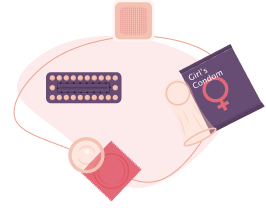
Female Condoms
The female condom is a sheath made to be used by women. It is made of thin transparent, polyurethane pre-lubricated with a silicone-based substance.How the method works
- It has a flexible ring at both ends; the ring at the closed end helps to insert the condom and the ring at the open end holds the condom outside the vagina.
- The female condoms prevent pregnancy by physically preventing the male sperm from gaining access to the woman’s reproductive system.
Effectiveness
- When used consistently and correctly in every sexual encounter, female condoms can be 95% effective.
- However, typical condom use is only moderately effective at about 79%.
Advantages
- Female condoms can be inserted up to eight hours before sexual activity.
- It is important to note that the female condom prevents both pregnancy and sexually transmitted infections.


Limitations
- Female condoms should not be used with a male condom as the friction can lead to the tearing of one or both condoms.
- When using female condoms, it is important not to use oil-based lubricants.
- Female condoms can also be made less effective by heat, light, and humidity.
- In addition, one may experience skin irritation or condom breakage.

Juu life ni kujipanga!
Popular questions
You will get a small injection on your arm to numb you. This means you won’t feel pain at all during insertion. There will be a little pain or soreness as the wound heals for about a week.
Yes. A woman who has not had children generally can use an IUD, but she should understand that the IUD is more likely to come out because her uterus may be smaller than the uterus of a woman who has given birth.
Yes. If needed, ECPs can be taken again, even in the same cycle. A woman who needs ECPs often may want to consider a longer-acting and more effective family planning method
Yes. A woman who has not had children generally can use an IUD, but she should understand that the IUD is more likely to come out because her uterus may be smaller than the uterus of a woman who has given birth.
No. Most research finds no major changes in bleeding patterns after female sterilization. If a woman was using a hormonal method or IUD before sterilization, her bleeding pattern will return to the way it was before she used these methods



